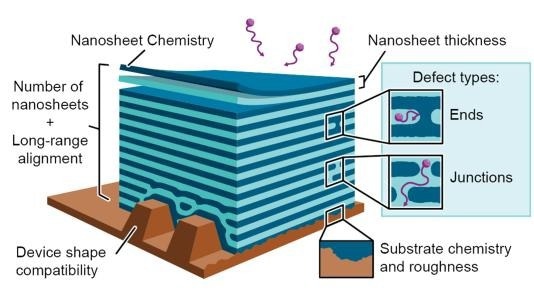Recently, a group at the Lawrence Berkeley National Laboratory of the US Department of Energy (DOE) has created a novel self-assembly technique for creating stacked 2D nanosheets as detailed in Nature.
 Artist’s rendition of stacked nanosheets for high-performance barrier coating, which requires a minimization of defects. Image Credit: Qingteng Zhang/Argonne National Laboratory
Artist’s rendition of stacked nanosheets for high-performance barrier coating, which requires a minimization of defects. Image Credit: Qingteng Zhang/Argonne National Laboratory
A nanosheet is an extremely tiny, ultrathin layer of polymer and nanoparticle-based material that resembles lasagna.
Some consumer devices will have a longer shelf life since these nanosheets contain far fewer flaws than earlier techniques. This new process might also facilitate a sustainable manufacturing strategy that minimizes the number of parts on an electronic device that must be disposed of in landfills, as the nanosheets produced are recyclable.
The group is the first to create a barrier material effectively with several uses and excellent performance using self-assembling nanosheets. At DOE's Argonne National Laboratory, researchers used the Advanced Photon Source (APS), a DOE Office of Science user facility.
Our work overcomes a longstanding hurdle in nanoscience — scaling up nanomaterial synthesis into useful materials for manufacturing and commercial applications. It is really exciting because this has been decades in the making.
Ting Xu, Study Principal Investigator and Senior Scientist, Lawrence Berkeley National Laboratory
Using nanoscience to make functioning materials is a problem since many small components must fit together. This is to allow the nanomaterial to expand to a useful size. Although one of the easiest methods to build nanomaterials into a product is to stack nanosheets, when dealing with pre-existing nanosheets, gaps between the sheets, or “stacking defects,” are inevitable.
If you visualize building a 3D structure from thin, flat tiles, you’ll have layers up the height of the structure. But you will also have gaps throughout each layer wherever two tiles meet. It is tempting to reduce the number of gaps by making the tiles bigger, but they become harder to work with.
Emma Vargo, Postdoctoral Researcher, Lawrence Berkeley National Laboratory
By eschewing the serial stacked sheet technique completely, the novel nanosheet material solves the stacking defect problem. Instead, the group combined mixtures of substances known to self-assemble into tiny particles. They employed component materials suspended in a solvent in alternating layers.
Research conducted at the DOE Office of Science user facility at Oak Ridge National Laboratory, the Spallation Neutron Source, enabled the researchers to gain insight into the initial, coarse phases of the blends’ self-assembly. The tiny particles clump together and spontaneously arrange, roughening the texture of the layers as the solvent evaporates.
After that, they harden into compact nanosheets. In this method, instead of stacking the ordered layers sequentially, they develop concurrently. For the little pieces to close gaps and get arranged, they need to move a short distance. Moving larger “tiles” and the inevitable spaces between them are avoided this way.
Two ideal qualities of the complex mix employed in this investigation were anticipated by the researchers. Additionally, they anticipated that variations in surface chemistries would have little impact on the novel nanosheet system. They reasoned that this would enable the same mixture to create a barrier of protection over a range of surfaces, such as polyester masks or the glass screen of electronic devices.
The researchers collaborated with some of the top research centers in the country to assess the material’s effectiveness as a barrier coating in a variety of applications.
Researchers at the APS examined how a blend of organic small molecules, polymers, and nanoparticles creates a coating on a quartz capillary tube’s inner wall while the solvent gradually evaporates in dry air.
Thanks to the brilliant X-Rays produced by the APS and the sophisticated X-Ray detector stationed at Beamline 8-ID-I, we were able to map out how each component comes together across a wide range of length scales.
Qingteng Zhang, Study Co-Author and Scientist, Lawrence Berkeley National Laboratory
The researchers now want to optimize the material’s recyclability after proving that it is simple to manufacture a varied functional material from a single nanomaterial for a range of industrial applications. They will also expand its repertoire by adding color tunability (it is now available in blue).
A thorough update is being performed on the APS. Once completed, the enhanced APS will allow probing of the nanoparticles’ self-assembly from the nanoscale to the device scale, commencing at the very beginning of the process.
Journal Reference:
Vargo, E., et. al. (2024) Functional composites by programming entropy-driven nanosheet growth. Nature. doi:10.1038/s41586-023-06660-x.